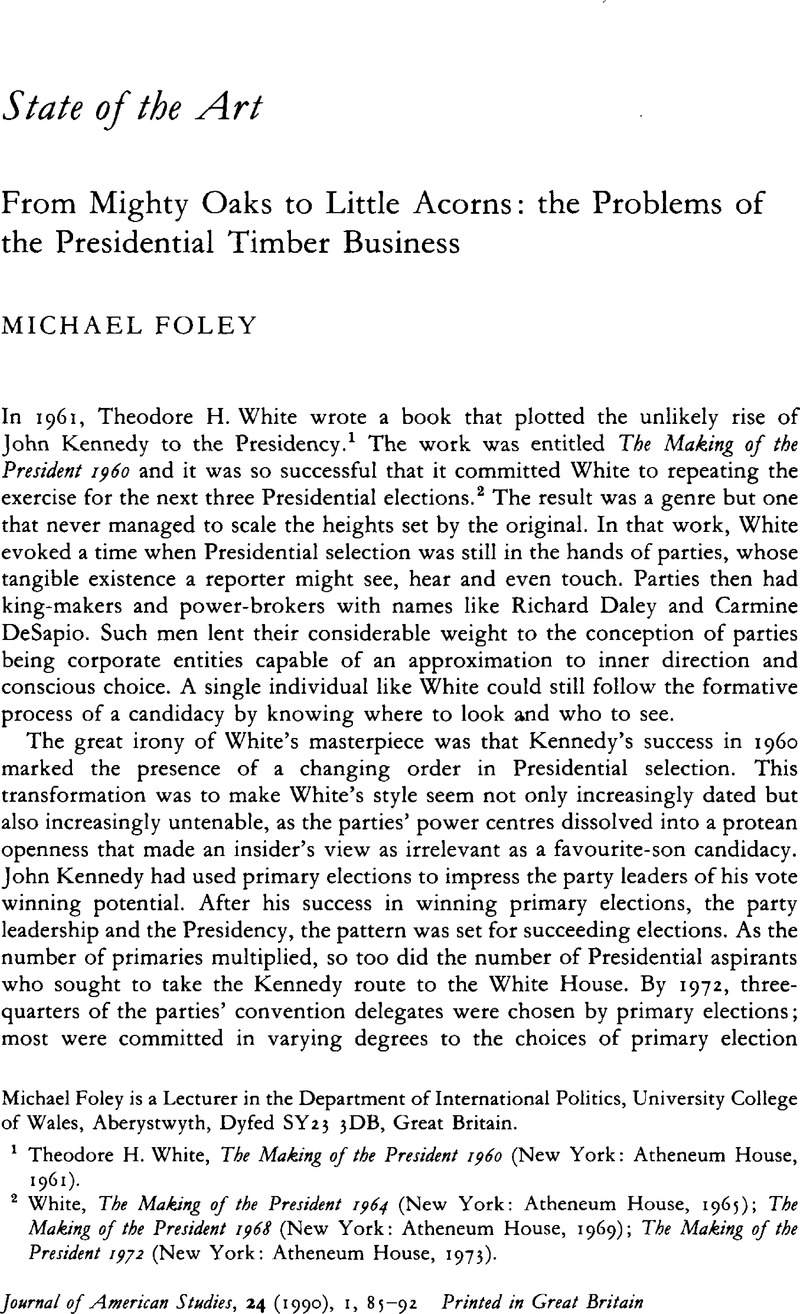No CrossRef data available.
Article contents
From Mighty Oaks to Little Acorns: the Problems of the Presidential Timber Business
Published online by Cambridge University Press: 16 January 2009
Abstract

- Type
- State of the Art
- Information
- Copyright
- Copyright © Cambridge University Press 1990
References
1 White, Theodore H., The Making of the President 1960 (New York: Atheneum House, 1961).Google Scholar
2 White, , The Making of the President 1964 (New York: Atheneum House, 1965)Google Scholar; The Making of the President 1968 (New York: Atheneum House, 1969)Google Scholar; The Making of the President 1972 (New York: Atheneum House, 1973).Google Scholar
3 Crotty, William, Party Reform (New York: Longman, 1985)Google Scholar; Polsby, Nelson W., The Consequences of Party Reform (New York: Oxford University Press, 1983)Google Scholar; Shafer, Byron E., The Party Reformed (New York: Basic, 1984).Google Scholar
4 Sabato, L., The Rise of Political Consultants (New York: Basic, 1981)Google Scholar; Malbin, Michael J. (ed.), Money and Politics in the United States: Financing Elections in the 1980s (Washington, D.C.: American Enterprise Institute for Public Policy Research, 1984)Google Scholar; Robinson, Michael J., “Where's the Beef? Media and Media Elites in 1984,” in Ranney, Austin (ed.), The American Elections of 1984 (Washington, D.C.: American Enterprise Institute for Public Policy Research, 1985), 166–202Google Scholar; Germond, Jack and Witcover, Jules, Blue Smoke and Mirrors: How Reagan Won and Carter Lost the Election of 1980 (New York: Viking, 1981)Google Scholar; Arterton, F. Christopher, Media Politics: The News Strategies of Presidential Campaigns (Lexington: Lexington Books, 1984)Google Scholar; Luntz, Frank I., Candidates, Consultants and Campaigns: The Style and Substance of American Electioneering (Oxford: Basil Blackwell, 1988).Google Scholar
5 For example, see Pomper, Gerald M. et al. , The Election of 1976: Reports and Interpretations (New York: Longman, 1977)Google Scholar; Ranney, (ed.), The American Elections of 1984Google Scholar; Abramson, Paul R., Aldrich, John H. and Rohde, David W., Change and Continuity in the 1984 Elections (Washington, D.C.: Congressional Quarterly, 1986).Google Scholar
6 The public has at its disposal a number of well written and intellectually accessible guide books. For example, Wayne, Stephen, The Road to the White House: The Politics of Presidential Elections, 2nd edn. (New York: Macmillan, 1980)Google Scholar; Polsby, Nelson W. and Wildavsky, Aaron, Presidential Elections: Contemporary Strategies of American Electoral Politics, 7th edn. (New York: Free Press, 1988).Google Scholar
7 In the 1988 Presidential election season, for example, no fewer than 25 Republicans and 21 Democrats had been mentioned as possible Presidential contenders. See Public Opinion, 03/04, 1987, 40.Google Scholar
8 Wattenberg, Martin P., The Decline of American Political Parties, 1952–1980 (Cambridge: Harvard University Press, 1984).Google Scholar
9 Blumenthal, Sidney, The Permanent Campaign, rev. edn. (New York: Simon and Schuster, 1983).Google Scholar
10 Neuman, W. Russell, The Paradox of Mass Politics: Knowledge and Opinion in the American Electorate (Cambridge: Harvard University Press, 1986).Google Scholar
11 Crotty, William and Jackson, John S. III, Presidential Primaries and Nominations (Washington, D.C.: Congressional Quarterly, 1985), 3.Google Scholar
12 Ceaser, James W., “Improving the Nomination Process,” in Reichley, A. James (ed.), Elections American Style (Washington, D.C.: The Brookings Institution, 1987), 29.Google Scholar
13 “Only Freaks,” The Economist, 9 05 1987.Google Scholar
14 “Oh, What a Screwy System,” Time, 25 01 1988.Google Scholar
15 Ceaser, , 33.Google Scholar
16 Crotty, and Jackson, , 3.Google Scholar
17 Pomper, Gerald M., “The Nominating Contests,” in Pomper, et al. , The Election of 1980: Reports and Interpretations (Chatham, N.J.: Chatham House, 1981), 3–4.Google Scholar
18 Kirkpatrick, Jeane J., The New Presidential Elite (New York: Sage, 1976)Google Scholar; Ladd, Everett C., Where Have All the Voters Gone? The Fracturing of America's Political Parties, 2nd edn. (New York: W. W. Norton, 1982).Google Scholar
19 Shafer, Byron E., “Anti-Party Politics,” in Lengle, James I. and Shafer, Byron E. (eds.), Presidential Politics: Readings on Nominations and Elections, 2nd edn. (New York: St. Martin's, 1980), 197.Google Scholar
20 For example, see Ladd, , “A Better Way to Pick Our Presidents,” Fortune, 5 05 1980, 132–36Google Scholar; Robinson, Donald L. (ed.), Reforming American Government: The Bicentennial Papers of the Committee on the Constitutional System (Boulder: Westview, 1985), 114–25Google Scholar; Sundquist, James L., Constitutional Reform and Effective Government (Washington, D.C.: The Brookings Institution, 1986), 177–89.Google Scholar
21 Hess, Stephen, “‘Why Great Men Are Not Chosen Presidents’: Lord Bryce Revisited,” in Reichley (ed.), 93–94.Google Scholar
22 Abramowitz, Alan I. and Stone, Walter J., Nomination Politics: Party Activists and Presidential Choice (New York: Praeger, 1984), 135.Google Scholar
23 Abramowitz, and Stone, , 136.Google Scholar
24 Bartels, Larry M., Presidential Primaries and the Dynamics of Public Choice (Princeton: Princeton University Press, 1988).Google Scholar
25 Ceaser, , “Improving the Nomination Process,” 29–51Google Scholar; Nelson, Michael, “The Case for the Current Presidential Nominating Process,” in Grassmuck, George (ed.), Before Nomination: Our Primary Problems (Washington, D.C.: American Enterprise Institute for Public Policy Research, 1985), 24–34.Google Scholar
26 Rose, Richard, The Postmodern President: The White House Meets the World (Chatham: Chatham House, 1988).Google Scholar
27 See Barber, James D., The Presidential Character: Predicting Performance in the White House, 2nd edn. (Englewood Cliffs: Prentice-Hall, 1977)Google Scholar; Lowi, Theodore J., The Personal President: Power Invested, Promise Unfulfilled (Ithaca: Cornell University Press, 1985).Google Scholar




